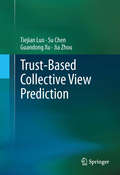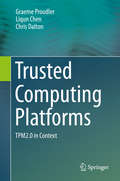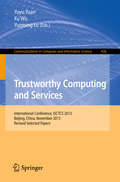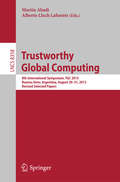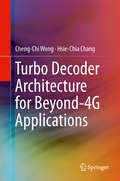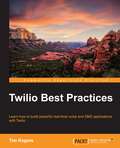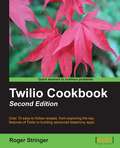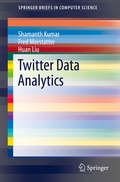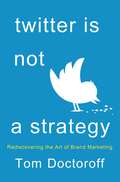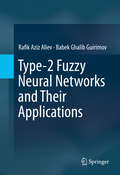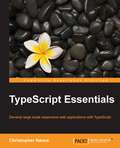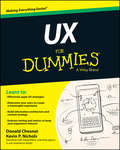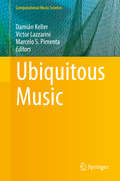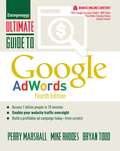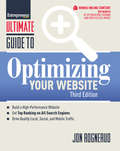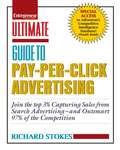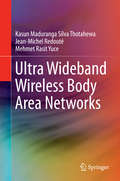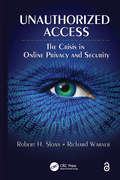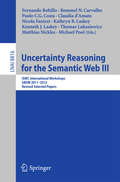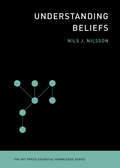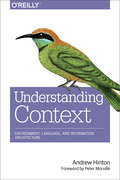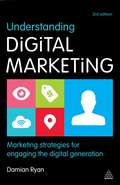- Table View
- List View
Trust, Computing, and Society
by Richard H.R. HarperThe internet has altered how people engage with each other in myriad ways, including offering opportunities for people to act distrustfully. This fascinating set of essays explores the question of trust in computing from technical, socio-philosophical, and design perspectives. Why has the identity of the human user been taken for granted in the design of the internet? What difficulties ensue when it is understood that security systems can never be perfect? What role does trust have in society in general? How is trust to be understood when trying to describe activities as part of a user requirement program? What questions of trust arise in a time when data analytics are meant to offer new insights into user behavior and when users are confronted with different sorts of digital entities? These questions and their answers are of paramount interest to computer scientists, sociologists, philosophers and designers confronting the problem of trust.
Trust-based Collective View Prediction
by Su Chen Guandong Xu Jia Zhou Tiejian LuoCollective view prediction is to judge the opinions of an active web user based on unknown elements by referring to the collective mind of the whole community. Content-based recommendation and collaborative filtering are two mainstream collective view prediction techniques. They generate predictions by analyzing the text features of the target object or the similarity of users' past behaviors. Still, these techniques are vulnerable to the artificially-injected noise data, because they are not able to judge the reliability and credibility of the information sources. Trust-based Collective View Prediction describes new approaches for tackling this problem by utilizing users' trust relationships from the perspectives of fundamental theory, trust-based collective view prediction algorithms and real case studies. The book consists of two main parts - a theoretical foundation and an algorithmic study. The first part will review several basic concepts and methods related to collective view prediction, such as state-of-the-art recommender systems, sentimental analysis, collective view, trust management, the Relationship of Collective View and Trustworthy, and trust in collective view prediction. In the second part, the authors present their models and algorithms based on a quantitative analysis of more than 300 thousand users' data from popular product-reviewing websites. They also introduce two new trust-based prediction algorithms, one collaborative algorithm based on the second-order Markov random walk model, and one Bayesian fitting model for combining multiple predictors. The discussed concepts, developed algorithms, empirical results, evaluation methodologies and the robust analysis framework described in Trust-based Collective View Prediction will not only provide valuable insights and findings to related research communities and peers, but also showcase the great potential to encourage industries and business partners to integrate these techniques into new applications.
Trusted Computing Platforms
by Graeme Proudler Liqun Chen Chris DaltonIn this book the authors first describe the background of trusted platforms and trusted computing and speculate about the future. They then describe the technical features and architectures of trusted platforms from several different perspectives, finally explaining second-generation TPMs, including a technical description intended to supplement the Trusted Computing Group's TPM2 specifications. The intended audience is IT managers and engineers and graduate students in information security.
Trustworthy Computing and Services
by Yuyu Yuan Xu Wu Yueming LuThis book constitutes the refereed proceedings of the International Standard Conference on Trustworthy Distributed Computing and Services, ISCTCS 2013, held in Beijing, China, in November 2013. The 49 revised full papers presented were carefully reviewed and selected from 267 papers. The topics covered are trustworthy infrastructure; security, survivability and fault tolerance; standards, evaluation and certification; trustworthiness of services.
Trustworthy Global Computing
by Alberto Lluch Lafuente Martín AbadiThis book constitutes the thoroughly refereed post-conference proceedings of the 8th International Symposium on Trustworthy Global Computing, TGC 2013, held in Buenos Aires, Argentina, in August 2013. The 15 revised full papers presented together with 3 invited talks were carefully reviewed and selected from 29 submissions. The papers cover a wide range of topics in the area of global computing and safe and reliable computation. They are organized in topical sections on security, π-calculus, information flow, models, specifications and proofs and quantitative analysis.
Trustworthy Global Computing: 8th International Symposium, TGC 2013, Buenos Aires, Argentina, August 30-31, 2013, Revised Selected Papers (Lecture Notes in Computer Science #8358)
by Martín Abadi and Alberto Lluch LafuenteThis book constitutes the thoroughly refereed post-conference proceedings of the 8th International Symposium on Trustworthy Global Computing, TGC 2013, held in Buenos Aires, Argentina, in August 2013. The 15 revised full papers presented together with 3 invited talks were carefully reviewed and selected from 29 submissions. The papers cover a wide range of topics in the area of global computing and safe and reliable computation. They are organized in topical sections on security, π-calculus, information flow, models, specifications and proofs and quantitative analysis.
Turbo Decoder Architecture for Beyond-4G Applications
by Cheng-Chi Wong Hsie-Chia ChangThis book describes the most recent techniques for turbo decoder implementation, especially for 4G and beyond 4G applications The authors reveal techniques for the design of high-throughput decoders for future telecommunication systems, enabling designers to reduce hardware cost and shorten processing time Coverage includes an explanation of VLSI implementation of the turbo decoder, from basic functional units to advanced parallel architecture. The authors discuss both hardware architecture techniques and experimental results, showing the variations in area/throughput/performance with respect to several techniques. This book also illustrates turbo decoders for 3GPP-LTE/LTE-A and IEEE 802. 16e/m standards, which provide a low-complexity but high-flexibility circuit structure to support these standards in multiple parallel modes. Moreover, some solutions that can overcome the limitation upon the speedup of parallel architecture by modification to turbo codec are presented here. Compared to the traditional designs, these methods can lead to at most 33% gain in throughput with similar performance and similar cost.
Twilio Best Practices
by Tim RogersIf you have experience with at least one programming language and are looking to integrate Twilio into your applications, then this book is for you.
Twilio Cookbook: Second Edition
by Roger StringerThis book is a practical, hands-on guide that provides the reader with a number of clear, step-by-step bite-size recipes. If you are a developer and want to learn about integrating Twilio's API into your websites for telephone solutions, then this book is for you. Basic knowledge of PHP and MySQL is expected.
Twitter Data Analytics
by Huan Liu Shamanth Kumar Fred MorstatterThis brief provides methods for harnessing Twitter data to discover solutions to complex inquiries. The brief introduces the process of collecting data through Twitter's APIs and offers strategies for curating large datasets. The text gives examples of Twitter data with real-world examples, the present challenges and complexities of building visual analytic tools, and the best strategies to address these issues. Examples demonstrate how powerful measures can be computed using various Twitter data sources. Due to its openness in sharing data, Twitter is a prime example of social media in which researchers can verify their hypotheses, and practitioners can mine interesting patterns and build their own applications. This brief is designed to provide researchers, practitioners, project managers, as well as graduate students with an entry point to jump start their Twitter endeavors. It also serves as a convenient reference for readers seasoned in Twitter data analysis.
Twitter is Not a Strategy
by Tom DoctoroffIn a cultural climate saturated by technology, marketing professionals have focused their energies on creating newer and more digital methods of advertising their brands, with the fear that if they don't embrace "Big Data," they will fade into obscurity. But Tom Doctoroff, Asia CEO for J. Walter Thompson, argues that this frenzy over digital and social media has created a schism in the marketing world that is hindering brands from attaining their true business potential. The tension between traditional branding and the seemingly unlimited possibilities presented by the advent of "digital" branding leads companies to abandon the tried and true aspects of marketing for the flash of the new. In Twitter is Not a Strategy, Doctoroff explains why a strategy that truly integrates the two ideas is the best way for a brand to move into the future. Using some of the biggest brand names in the world as examples, such as Coca-Cola, Nike, and Apple, he breaks down the framework of marketing to explain how digital marketing can't stand without the traditional foundation.
Type-2 Fuzzy Neural Networks and Their Applications
by Rafik Aziz Aliev Babek Ghalib GuirimovThis book deals with the theory, design principles, and application of hybrid intelligent systems using type-2 fuzzy sets in combination with other paradigms of Soft Computing technology such as Neuro-Computing and Evolutionary Computing. It provides a self-contained exposition of the foundation of type-2 fuzzy neural networks and presents a vast compendium of its applications to control, forecasting, decision making, system identification and other real problems. Type-2 Fuzzy Neural Networks and Their Applications is helpful for teachers and students of universities and colleges, for scientists and practitioners from various fields such as control, decision analysis, pattern recognition and similar fields.
TypeScript Essentials
by Christopher NanceThe book introduces the TypeScript language and its features to anyone looking to develop rich web applications. Whether you are new to web development or are an experienced engineer with strong JavaScript skills, this book will get you writing code quickly. A basic understanding of JavaScript and its language features are necessary for this book.
UX For Dummies
by Donald Chesnut Kevin NicholsGet up to speed quickly on the latest in user experience strategy and designUX For Dummies is a hands-on guide to developing and implementing user experience strategy. Written by globally-recognized UX consultants, this essential resource provides expert insight and guidance on using the tools and techniques that create a great user experience, along with practical advice on implementing a UX strategy that aligns with your organisation's business goals and philosophy. You'll learn how to integrate web design, user research, business planning and data analysis to focus your company's web presence on the needs of your customers, gaining the skills you need to be effective in the field of user experience design.Whether it's the interface, graphics, industrial design, physical interaction or a user manual, being anything less than on point can negatively affect customer satisfaction and retention. User experience design fully encompasses traditional human-computer interaction design, and extends it to address all aspects of a product or service as perceived by users. UX For Dummies provides comprehensive guidance to professionals looking to understand and apply effective UX strategies.Defines UX and offers assistance with determining users and modelling the user experienceProvides details on creating a content strategy and building information architecturesExplores visual design and designing for specific channelsDelves into UX testing and methods for keeping your site relevantThe UX field is growing rapidly as companies realise that meeting your business goals requires a web presence aligned with customer needs. This alignment demands smart strategy and even smarter design. Consultants, designers and practitioners must all be on board if the result is to be cohesive and effective. UX For Dummies provides the information and expert advice you need to get up to speed quickly.
Ubiquitous Music
by Damián Keller Victor Lazzarini Marcelo S. PimentaThis is the first monograph dedicated to this interdisciplinary research area, combining the views of music, computer science, education, creativity studies, psychology, and engineering. The contributions include introductions to ubiquitous music research, featuring theory, applications, and technological development, and descriptions of permanent community initiatives such as virtual forums, multi-institutional research projects, and collaborative publications. The book will be of value to researchers and educators in all domains engaged with creativity, computing, music, and digital arts.
Ultimate Guide to Google AdWords
by Perry Marshall Bryan Todd Mike RhodesGoogle processes nearly 6 billion searches every day-making it a powerful advertising medium your business can't afford to ignore. Google AdWords experts Perry Marshall and Bryan Todd, joined by AdWords and analytics specialist Mike Rhodes, present the fundamentals, techniques, tools, and tricks that Google should teach you, but doesn't.This latest edition introduces revised, expanded, and new chapters covering Enhanced Campaigns, Google AdWords Express, and Google's Product Listing Ads, as well as an introduction to Google's Universal Analytics.You'll learn how to:Master Enhanced Campaigns, Google Shopping Campaigns, and Google Analytics Implement flexible bid strategies that keep you on budget Triple traffic with Google's Display Network Profit using local advertising Corner the second largest search engine with YouTube ads Avoid costly mistakes made by most Google advertisers Chisel your way into tough markets Write killer advertising and website copy that gets clicks Determine what is and isn't working with Google's AdWords
Ultimate Guide to Optimizing Your Website
by Jon RognerudWritten for beginners, author Jon Rognerud offers every tip, trick, and secret from keyword research and competitive analysis, to marketing and messaging, content development, link building, and conversions and tracking of search engine positions. Local search, social media, and blogging are new to this edition, and show examples on how to optimize these important new development areas. Updated content includes social media search content that reflects strategies and market information to helps business owners easily add this companion to SEO work, blog optimization steps with best SEO tactics for creating search engine friendly sites, and the top ten hottest WordPress plugins for top traffic boost. A local SEO section shows readers how to avoid the most common mistakes on optimizaing for local search and the updated section on Google analytics shows how to track top keywords and pages. An updated link building section provides new white hat SEO link building tactics to provide better long term rankings and traffic building, and an expanded resource section includes updated screen-shots of SEO applied. Step-by-step examples are written with an "at the kitchen table" type dialogue for accessibility and an advanced strategy section takes readers to the next level.
Ultimate Guide to Pay-Per-Click Advertising
by Richard StokesMillions compete for exposure on Google, Yahoo!, and Bing, but 99% of them fail to get results. As the founder of leading digital intelligence firm, AdGooroo, search advertising authority Richard Stokes is in a unique position to reveal what's going wrong and provide solutions to fix it.Since the publication of the first edition, there have been a number of revolutionary changes in paid search. First, we are increasingly searching from our cell phones - not just desktops. Mobile search now accounts for 15% of searches in the US (up from ~0% in 2009). Second, Google is no longer the only game in town. Bing now accounts for 30% of all US searches and is growing in importance worldwide. Finally, "Search Extensions" have become a powerful new technique that search advertisers can use to gain an edge on the competition. With them, advertisers can collect phone numbers and email addresses with their ads, limit their ads to certain times of day, deliver coupons to nearby customers, and even provide handy "call me" buttons that are displayed only on cell phones. In this new edition, Stokes details all this and more, providing information exclusive to this guide and of priceless value to its more advanced search audience.With insider insight from Stokes and using proven strategies from today's search advertising elite, paid search advertisers discover how to drive significantly more traffic to their site, dramatically increase click-through rates, steal impressions from competitors, boost their conversions, and increase their sales by unbelievable amounts.
Ultra Wideband Wireless Body Area Networks
by Kasun Maduranga Silva Thotahewa Jean-Michel Redouté Mehmet Rasit YuceThis book explores the design of ultra wideband (UWB) technology for wireless body-area networks (WBAN) The authors describe a novel implementation of WBAN sensor nodes that use UWB for data transmission and narrow band for data reception, enabling low power sensor nodes, with high data rate capability The discussion also includes power efficient, medium access control (MAC) protocol design for UWB based WBAN applications and the authors present a MAC protocol in which a guaranteed delivery mechanism is utilized to transfer data with high priority Readers will also benefit from this book's feasibility analysis of the UWB technology for human implant applications through the study of electromagnetic and thermal power absorption of human tissue that is exposed to UWB signals
Unauthorized Access: The Crisis in Online Privacy and Security
by Richard Warner Robert SloanGoing beyond current books on privacy and security, this book proposes specific solutions to public policy issues pertaining to online privacy and security. Requiring no technical or legal expertise, it provides a practical framework to address ethical and legal issues. The authors explore the well-established connection between social norms, privacy, security, and technological structure. They also discuss how rapid technological developments have created novel situations that lack relevant norms and present ways to develop these norms for protecting informational privacy and ensuring sufficient information security.
Uncertainty Reasoning for the Semantic Web III
by Fernando Bobillo Rommel N. Carvalho Paulo C. G. Costa Claudia D'Amato Nicola Fanizzi Kathryn B. Laskey Kenneth J. Laskey Thomas Lukasiewicz Matthias Nickles Michael PoolThis book contains revised and significantly extended versions of selected papers from three workshops on Uncertainty Reasoning for the Semantic Web (URSW), held at the International Semantic Web Conferences (ISWC) in 2011, 2012, and 2013. The 16 papers presented were carefully reviewed and selected from numerous submissions. The papers included in this volume are organized in topical sections on probabilistic and Dempster-Shafer models, fuzzy and possibilistic models, inductive reasoning and machine learning, and hybrid approaches.
Understanding Beliefs (The MIT Press Essential Knowledge Series)
by Nils J. NilssonWhat beliefs are, what they do for us, how we come to hold them, and how to evaluate them. Our beliefs constitute a large part of our knowledge of the world. We have beliefs about objects, about culture, about the past, and about the future. We have beliefs about other people, and we believe that they have beliefs as well. We use beliefs to predict, to explain, to create, to console, to entertain. Some of our beliefs we call theories, and we are extraordinarily creative at constructing them. Theories of quantum mechanics, evolution, and relativity are examples. But so are theories about astrology, alien abduction, guardian angels, and reincarnation. All are products (with varying degrees of credibility) of fertile minds trying to find explanations for observed phenomena. In this book, Nils Nilsson examines beliefs: what they do for us, how we come to hold them, and how to evaluate them. We should evaluate our beliefs carefully, Nilsson points out, because they influence so many of our actions and decisions.Some of our beliefs are more strongly held than others, but all should be considered tentative and changeable. Nilsson shows that beliefs can be quantified by probability, and he describes networks of beliefs in which the probabilities of some beliefs affect the probabilities of others. He argues that we can evaluate our beliefs by adapting some of the practices of the scientific method and by consulting expert opinion. And he warns us about “belief traps”—holding onto beliefs that wouldn't survive critical evaluation. The best way to escape belief traps, he writes, is to expose our beliefs to the reasoned criticism of others.
Understanding Context: Environment, Language, and Information Architecture
by Andrew HintonTo make sense of the world, we’re always trying to place things in context, whether our environment is physical, cultural, or something else altogether. Now that we live among digital, always-networked products, apps, and places, context is more complicated than ever—starting with "where" and "who" we are.This practical, insightful book provides a powerful toolset to help information architects, UX professionals, and web and app designers understand and solve the many challenges of contextual ambiguity in the products and services they create. You’ll discover not only how to design for a given context, but also how design participates in making context.Learn how people perceive context when touching and navigating digital environmentsSee how labels, relationships, and rules work as building blocks for contextFind out how to make better sense of cross-channel, multi-device products or servicesDiscover how language creates infrastructure in organizations, software, and the Internet of ThingsLearn models for figuring out the contextual angles of any user experience
Understanding Digital Marketing
by Damian RyanThe world of digital media is changing at a phenomenal pace. Constantly evolving technologies, and the way people are using them, are transforming not just how we access our information but how we interact and communicate with one another on a global scale.Understanding Digital Marketing is a practical, no-nonsense guide to digital marketing channels and strategy. Clear, informative and entertaining it will help readers to:. Understand and choose online marketing channels to get their products and services to market with detailed chapters on: search; email; social media; mobile; performance marketing; online PR and content marketing. Understand the origins of digital marketing; the scale of the current online marketplace and its unfolding opportunities; and the trends that are shaping its future. Achieve the competitive edge to keep them ahead of the packOne of the bestselling books in the industry, this third edition has been thoroughly revised throughout with more chapters and a deeper, more advanced level of expertise in core areas such as search, analytics, online PR and content marketing.Essential reading for both practitioners and students alike, and including in-depth insider accounts of digital marketing successes from brands including Harley-Davidson, Help for Heroes, Mercadolibre and the UEFA Europa League, Understanding Digital Marketing provides readers with tools to utilize the power of the internet to take their company wherever they want it to go.
Understanding Machine Learning
by Shai Shalev-Shwartz Shai Ben-DavidMachine learning is one of the fastest growing areas of computer science, with far-reaching applications. The aim of this textbook is to introduce machine learning, and the algorithmic paradigms it offers, in a principled way. The book provides a theoretical account of the fundamentals underlying machine learning and the mathematical derivations that transform these principles into practical algorithms. Following a presentation of the basics, the book covers a wide array of central topics unaddressed by previous textbooks. These include a discussion of the computational complexity of learning and the concepts of convexity and stability; important algorithmic paradigms including stochastic gradient descent, neural networks, and structured output learning; and emerging theoretical concepts such as the PAC-Bayes approach and compression-based bounds. Designed for advanced undergraduates or beginning graduates, the text makes the fundamentals and algorithms of machine learning accessible to students and non-expert readers in statistics, computer science, mathematics and engineering.

